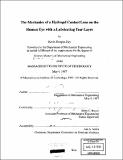| dc.contributor.advisor | Mary C. Boyce. | en_US |
| dc.contributor.author | Day, Kevin Douglas | en_US |
| dc.date.accessioned | 2008-11-07T20:15:59Z | |
| dc.date.available | 2008-11-07T20:15:59Z | |
| dc.date.copyright | 1997 | en_US |
| dc.date.issued | 1997 | en_US |
| dc.identifier.uri | http://hdl.handle.net/1721.1/43596 | |
| dc.description | Thesis (S.M.)--Massachusetts Institute of Technology, Dept. of Mechanical Engineering, 1997. | en_US |
| dc.description | Includes bibliographical references (p. 113-114). | en_US |
| dc.description.abstract | The mechanics governing the fit of a soft contact lens on the eye are examined through the development of a finite element analysis model. A linearly elastic lens is placed on a rigid eye with a lubricating viscoelastic tear layer. The mechanics of fit are described in terms of the pressure distribution through the tear layer, the contact pressure at the lens/tear interface, the tear film thickness, and the bending and membrane stresses in the contact lens itself. A parametric study is performed to investigate the impact of model assumptions of initial tear film thickness, tear film material properties, and eye geometries on the results predicted by the numerical simulations. Further study is performed to investigate the impact of certain geometric lens parameters and how variations in lens thickness, sagittal height, bevel curve design, and back surface design affect the mechanics of the contact lens. A three dimensional model is also developed to investigate mobility and stability issues. The strain energy is monitored as the lens is moved across the eye as it would move during a blink of the eye. Mobility is measured both through the total strain energy present in the lens and the strain energy gradient near the equilibrium position of the lens as a function of displacement on the eye. In addition to strain energy values, the force required to move the lens across the surface of the eye is monitored. The long term goal of this work is to develop a numerical tool to assist in the design and development of new lens geometries for better fit and mobility of soft contact lenses. | en_US |
| dc.description.statementofresponsibility | by Kevin Douglas Day. | en_US |
| dc.format.extent | 114 p. | en_US |
| dc.language.iso | eng | en_US |
| dc.publisher | Massachusetts Institute of Technology | en_US |
| dc.rights | M.I.T. theses are protected by
copyright. They may be viewed from this source for any purpose, but
reproduction or distribution in any format is prohibited without written
permission. See provided URL for inquiries about permission. | en_US |
| dc.rights.uri | http://dspace.mit.edu/handle/1721.1/7582 | en_US |
| dc.subject | Mechanical Engineering | en_US |
| dc.title | The mechanics of a hydrogel contact lens on the human eye with a lubricating tear layer | en_US |
| dc.type | Thesis | en_US |
| dc.description.degree | S.M. | en_US |
| dc.contributor.department | Massachusetts Institute of Technology. Department of Mechanical Engineering | en_US |
| dc.identifier.oclc | 42686202 | en_US |
